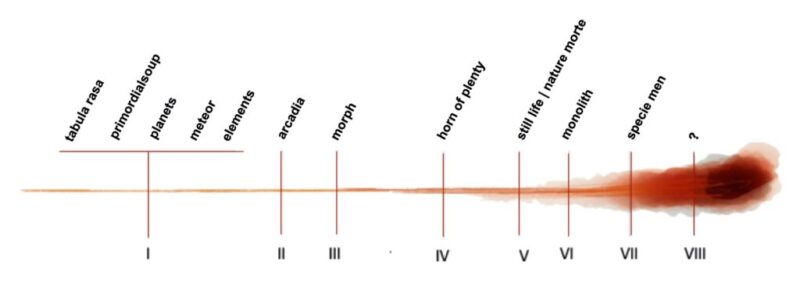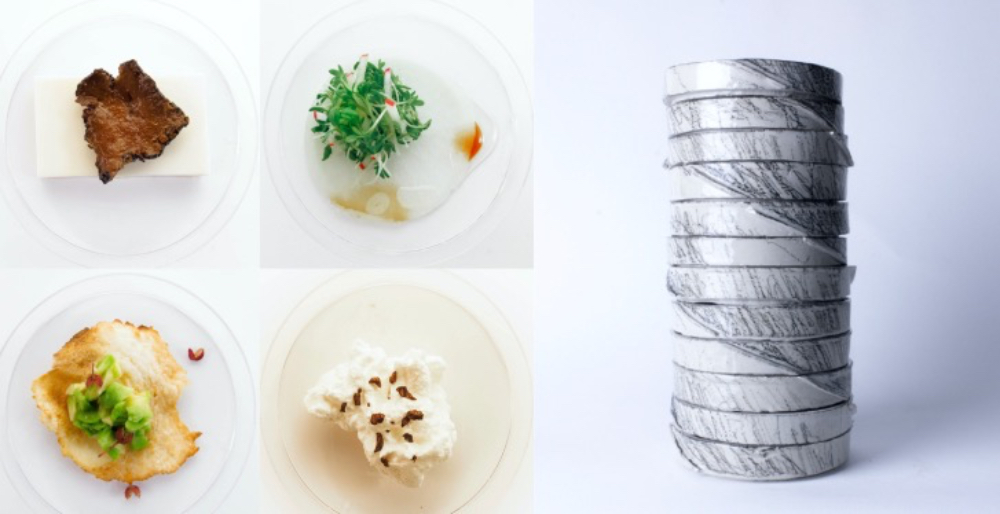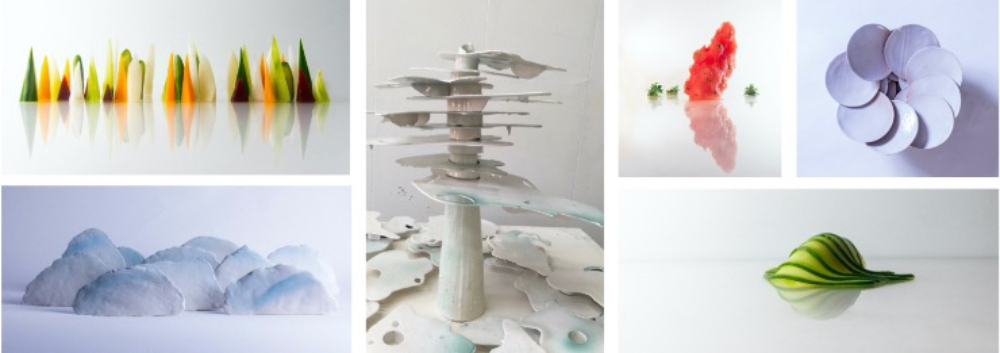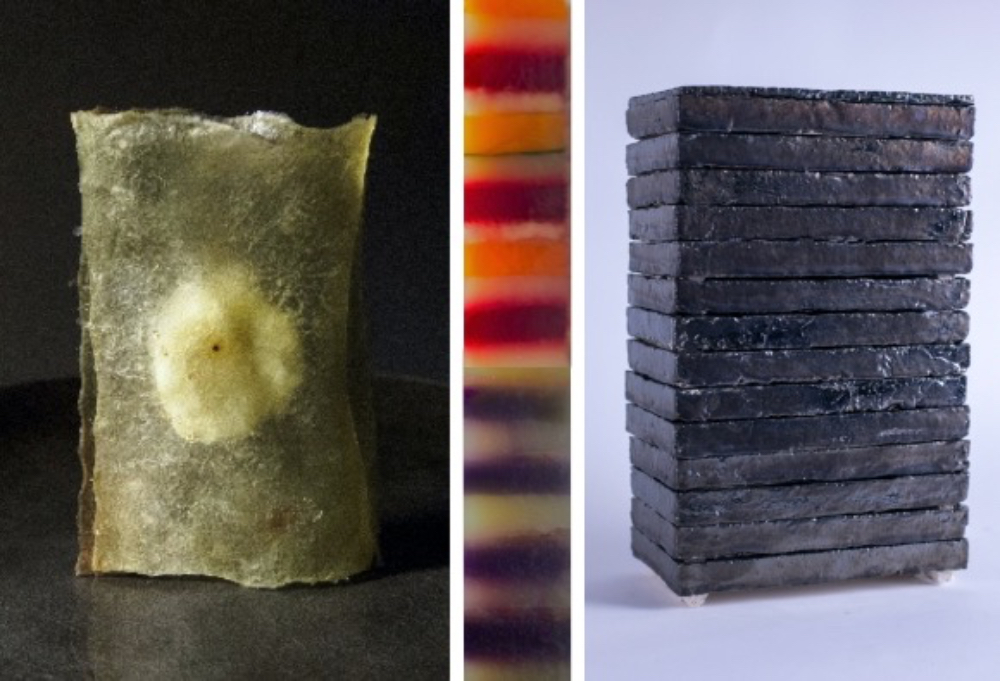cosmos chromosome
a delicious representation of the dawn of man
‘But food, for all that, is not art…’
‘It is not narrative or representative, does not organize and express emotion’.
William Deresiewicz, New York Times, 28 October 2012
Cosmos chromosome is a multimedia seven+ course dinner with, as leitmotif, the beginning of the cosmos to the birth of man. Darwin’s theory of evolution, Pythagorean number theory, 2001: A Space Odyssey by Stanley Kubrick and the Book of Genesis have been used as inspiration to shape cosmos chromosome.
Food as Language
In cosmos chromosome I explore whether symbolism can be used to create a food language and food as a narrative medium, that goes further than a specific symbolic meaning attributed to a specific ingredient or dish.
In this dinner, food symbolism (religious and profane) as well as scientific, philosophical and artistic ideas are freely used to compose a food language. The ingredients and dishes are layered with a meaning that extends beyond their nutritional value, taste and appearance.
For centuries, certain foods and dishes have had a symbolic meaning – often referring to religious events, but also to worldly rituals.
- For Hindus, the coconut represents Lord Shiva and is offered in most rituals and ceremonies.
- The matzah at Pesach reminds Jews of their exodus out of Egypt.
- The Catholic wafer symbolises the body of Christ.
- Muslims eat dates at iftar, symbolically recalling the moment the prophet Muhammad broke his fast.
- In ancient Greek culture, the Pythagoreans wouldn’t eat white beans owing to their resemblance to a foetus.
- Oysters have long had sexual connotations in both eastern and western cultures.
- Japanese Wagashi, a traditional sweet confection, have a highly defined meaning that derives from their name, form and seasonality.
The cosmos chromosome narrative idea also has echoes of Anthony Burgess, who, in Earthly Powers (1980), wrote:
‘I mean, a Western banquet recapitulates the history of the earth from primal broth through sea beasts to land predators and flying creatures and ends with evidence of human culture in cheese and artful puddings’.
In cosmos chromosome, the narrative is told through a series of seven+ courses. The vessels specially made for this dinner follow the same narrative.
Below, you will find a selection of dishes and vessels from cosmos chromosome, to give you a visual impression of how the dinner might look. All the sketches, dishes and vessels can be found in the book Curious Catalogue (forthcoming).
The bloodline (below) represents a timeline, showing the structure of how the dinner is conceived, inspired by some of the key theories of creation/evolution, and artistic and philosophical ideas.
dawn | primordial soup, elements, monolith | cherry-colourd funk

Tabula Rasa
The phase marked “Tabula Rasa” to “Elements” is conceived as a series of starters – the birth of creation. The first takes the form of a snack comprising ingredients such as charcoaled fern fiddleheads (chosen for their fractal and spiral appearance and their association with number theory), milk skin – a reference to the Milky Way – and dehydrated white beans, with their foetus-like appearance.
Emphasising the link with number theory, these ingredients are served on a flat white, rectangular-shaped vessel, whose dimensions and form are determined by the golden ratio. This Tabula Rasa vessel, is a blank slate where nature, art and science meet.

Milky Way | tabula rasa | cra cra
Elements
The four Elements (earth, water, air and fire), in mythology the basis for all matter, are combined with the four tastes – sweet, sour, salty and bitter.
Of a possible 16 Element dishes, four are shown here: truffled soy is the combination of earth and sweet; for water and sour we created lavender pickled radish. White beans and olive merengue represents air and salt. Szechuan balsam pear is the combination of fire and bitter.
All the elements are presented in ceramic cell culture dishes that combine to form a helix.

truffled soy | lavender pickled radish | Szechuan balsam pear | white beans/olive merengue | Helix vessel
Arcadia
Foodscapes visualise the ‘creation’ of earth. Due to their highly seasonally character, the ingredients – and the foodscapes – embody time. The 12 foodscapes are served on the mountain,
tree or flower vessels. Shown are the city (summer roots), rock (pressed melon/tarragon) and hedgerow (cucumber/mung beans)

city | mountain vessel | tree vessel | rock | flower vessel | hedgerow
Morph
This course portrays the morphing / evolution of ‘simple’ cells into invertebrates such as molluscs and crustaceans. Two dishes are given as examples: mussel spherification and uni rice foam, served in one of the coral vessels, which also show the morphing sequence.

mussel specification | uni, rice foam | urchin vessel | coral vessel
Horn of Plenty
nussel spherification | uni, ricefoam | urchin vessel | coral vessel
In this phase the fish make their entry. Besides being part of the overall narrative, the four fish dishes tell their own story of life and death. The ikan teri and black rice dish is presented as a school of fish served on the wave vessel inspired by Hokusai’s Great Wave; cod in mung beans noodle on a porcelain fishnet; lacquered trout/potato; and finally crispy head and skin presented on the X-on oil-spot vessel.

cod, mung beans | head & tail | fish net vessel | wave vessel
Still Life | Nature Morte
The dishes created here have their origin in biblical stories. The rib of Adam, from which woman was created. And the dove released by Noah.
The rib, wine and bread, and pigeon-olive dishes are served in a ceramic dodo-skull vessel.

dove & olive | dodo vessel | rib, bread & wine
Monolith
The monolith is taken from Stanley Kubrick’s film 2001: A Space Odyssey. As a monolith appears in an African-like landscape, apes begin to evolve.
For cosmos chromosome, this concept has been translated into a variety of cheese dishes, served in rectangular dishes that, when stacked, form a monolith.

goatcheese, potato | legumes/cheese fondu | monolith vessel
Specie Men
The final stage in this evolutionary dinner is the birth of man.
Spiced Passion (pasion fruit, spiced rosewater and basil seed) opens this course, served in the torso vessel. It continues with a variety of desserts symbolising the different types of man.
- The fruit jellies/reflection is based on Leonardo’s Vitruvian Man.
- The Modular Man – à la Le Corbusier.
- O’Men! (chocolate, pine nuts, saffron scent) in the form of medicaments and presented in a Mondriaan-style medicine box echoes Damien Hirst’s medicine cabinet ‘Bodies’. The title O’Men! refers to the film ‘Omen’, whose main character Damien is portrayed as the son of the Devil.
- Trans, the final element in this course, is a golden biscuit in the form of an archaic statuette, the Phallus Venus.


spiced passion | torso vessel | O’Men | Trans | Vitruvius